+ Open data
Open data
- Basic information
Basic information
| Entry | Database: PDB / ID: 6kgi | ||||||
|---|---|---|---|---|---|---|---|
| Title | RLGS-yUbr1 Ubr box | ||||||
 Components Components | E3 ubiquitin-protein ligase UBR1 | ||||||
 Keywords Keywords | LIGASE / Ubr1 / Ubr box | ||||||
| Function / homology |  Function and homology information Function and homology informationregulation of dipeptide transport / UBR1-RAD6 ubiquitin ligase complex / proteasome regulatory particle binding / ubiquitin-dependent protein catabolic process via the N-end rule pathway / stress-induced homeostatically regulated protein degradation pathway / mitochondria-associated ubiquitin-dependent protein catabolic process / cytoplasm protein quality control by the ubiquitin-proteasome system / proteasome regulatory particle, base subcomplex / ribosome-associated ubiquitin-dependent protein catabolic process / Antigen processing: Ubiquitination & Proteasome degradation ...regulation of dipeptide transport / UBR1-RAD6 ubiquitin ligase complex / proteasome regulatory particle binding / ubiquitin-dependent protein catabolic process via the N-end rule pathway / stress-induced homeostatically regulated protein degradation pathway / mitochondria-associated ubiquitin-dependent protein catabolic process / cytoplasm protein quality control by the ubiquitin-proteasome system / proteasome regulatory particle, base subcomplex / ribosome-associated ubiquitin-dependent protein catabolic process / Antigen processing: Ubiquitination & Proteasome degradation / protein monoubiquitination / cellular response to unfolded protein / ubiquitin ligase complex / ERAD pathway / RING-type E3 ubiquitin transferase / protein polyubiquitination / ubiquitin-protein transferase activity / ubiquitin protein ligase activity / protein ubiquitination / zinc ion binding / cytoplasm Similarity search - Function | ||||||
| Biological species |  | ||||||
| Method |  X-RAY DIFFRACTION / X-RAY DIFFRACTION /  SYNCHROTRON / SYNCHROTRON /  MOLECULAR REPLACEMENT / Resolution: 1.04 Å MOLECULAR REPLACEMENT / Resolution: 1.04 Å | ||||||
 Authors Authors | Heo, J. / Kwon, D.H. / Kim, L. / Song, H.K. | ||||||
 Citation Citation |  Journal: J.Biol.Chem. / Year: 2020 Journal: J.Biol.Chem. / Year: 2020Title: Use of the LC3B-fusion technique for biochemical and structural studies of proteins involved in the N-degron pathway. Authors: Kim, L. / Kwon, D.H. / Heo, J. / Park, M.R. / Song, H.K. | ||||||
| History |
|
- Structure visualization
Structure visualization
| Structure viewer | Molecule:  Molmil Molmil Jmol/JSmol Jmol/JSmol |
|---|
- Downloads & links
Downloads & links
- Download
Download
| PDBx/mmCIF format |  6kgi.cif.gz 6kgi.cif.gz | 45.3 KB | Display |  PDBx/mmCIF format PDBx/mmCIF format |
|---|---|---|---|---|
| PDB format |  pdb6kgi.ent.gz pdb6kgi.ent.gz | 30.5 KB | Display |  PDB format PDB format |
| PDBx/mmJSON format |  6kgi.json.gz 6kgi.json.gz | Tree view |  PDBx/mmJSON format PDBx/mmJSON format | |
| Others |  Other downloads Other downloads |
-Validation report
| Summary document |  6kgi_validation.pdf.gz 6kgi_validation.pdf.gz | 419.7 KB | Display |  wwPDB validaton report wwPDB validaton report |
|---|---|---|---|---|
| Full document |  6kgi_full_validation.pdf.gz 6kgi_full_validation.pdf.gz | 420.1 KB | Display | |
| Data in XML |  6kgi_validation.xml.gz 6kgi_validation.xml.gz | 5.6 KB | Display | |
| Data in CIF |  6kgi_validation.cif.gz 6kgi_validation.cif.gz | 6.8 KB | Display | |
| Arichive directory |  https://data.pdbj.org/pub/pdb/validation_reports/kg/6kgi https://data.pdbj.org/pub/pdb/validation_reports/kg/6kgi ftp://data.pdbj.org/pub/pdb/validation_reports/kg/6kgi ftp://data.pdbj.org/pub/pdb/validation_reports/kg/6kgi | HTTPS FTP |
-Related structure data
| Related structure data |  6kgjC  6khzC  6lhnC  3nitS S: Starting model for refinement C: citing same article ( |
|---|---|
| Similar structure data |
- Links
Links
- Assembly
Assembly
| Deposited unit | 
| ||||||||
|---|---|---|---|---|---|---|---|---|---|
| 1 | 
| ||||||||
| Unit cell |
|
- Components
Components
| #1: Protein | Mass: 9678.886 Da / Num. of mol.: 1 / Fragment: Ubr box Source method: isolated from a genetically manipulated source Source: (gene. exp.)  Strain: ATCC 204508 / S288c / Gene: UBR1, PTR1, YGR184C, G7168 / Production host:  References: UniProt: P19812, RING-type E3 ubiquitin transferase | ||||
|---|---|---|---|---|---|
| #2: Chemical | | #3: Water | ChemComp-HOH / | Has ligand of interest | N | |
-Experimental details
-Experiment
| Experiment | Method:  X-RAY DIFFRACTION / Number of used crystals: 1 X-RAY DIFFRACTION / Number of used crystals: 1 |
|---|
- Sample preparation
Sample preparation
| Crystal | Density Matthews: 3.31 Å3/Da / Density % sol: 62.89 % |
|---|---|
| Crystal grow | Temperature: 293 K / Method: vapor diffusion, sitting drop / Details: 0.1M BIS-Tris pH 6.5, 2.7-3.0M NaCl |
-Data collection
| Diffraction | Mean temperature: 193 K / Serial crystal experiment: N |
|---|---|
| Diffraction source | Source:  SYNCHROTRON / Site: SYNCHROTRON / Site:  Photon Factory Photon Factory  / Beamline: BL-17A / Wavelength: 0.9 Å / Beamline: BL-17A / Wavelength: 0.9 Å |
| Detector | Type: DECTRIS PILATUS3 S 6M / Detector: PIXEL / Date: May 4, 2018 |
| Radiation | Protocol: SINGLE WAVELENGTH / Monochromatic (M) / Laue (L): M / Scattering type: x-ray |
| Radiation wavelength | Wavelength: 0.9 Å / Relative weight: 1 |
| Reflection | Resolution: 1.04→50 Å / Num. obs: 62982 / % possible obs: 100 % / Redundancy: 12.5 % / Net I/σ(I): 43.9 |
| Reflection shell | Resolution: 1.04→1.06 Å / Num. unique obs: 6200 |
- Processing
Processing
| Software |
| ||||||||||||||||||||||||||||||||||||||||||||||||||||||||||||||||||||||||||||||||||||||||||
|---|---|---|---|---|---|---|---|---|---|---|---|---|---|---|---|---|---|---|---|---|---|---|---|---|---|---|---|---|---|---|---|---|---|---|---|---|---|---|---|---|---|---|---|---|---|---|---|---|---|---|---|---|---|---|---|---|---|---|---|---|---|---|---|---|---|---|---|---|---|---|---|---|---|---|---|---|---|---|---|---|---|---|---|---|---|---|---|---|---|---|---|
| Refinement | Method to determine structure:  MOLECULAR REPLACEMENT MOLECULAR REPLACEMENTStarting model: 3NIT Resolution: 1.04→30.25 Å / SU ML: 0.09 / Cross valid method: FREE R-VALUE / σ(F): 1.35 / Phase error: 17.89
| ||||||||||||||||||||||||||||||||||||||||||||||||||||||||||||||||||||||||||||||||||||||||||
| Solvent computation | Shrinkage radii: 0.99 Å / VDW probe radii: 1.11 Å / Solvent model: FLAT BULK SOLVENT MODEL | ||||||||||||||||||||||||||||||||||||||||||||||||||||||||||||||||||||||||||||||||||||||||||
| Displacement parameters | Biso mean: 17.8948 Å2 | ||||||||||||||||||||||||||||||||||||||||||||||||||||||||||||||||||||||||||||||||||||||||||
| Refinement step | Cycle: LAST / Resolution: 1.04→30.25 Å
| ||||||||||||||||||||||||||||||||||||||||||||||||||||||||||||||||||||||||||||||||||||||||||
| LS refinement shell | Refine-ID: X-RAY DIFFRACTION / Rfactor Rfree error: 0 / Total num. of bins used: 14 / % reflection obs: 100 %
|
 Movie
Movie Controller
Controller



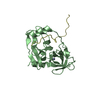
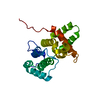

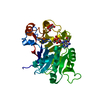
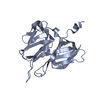



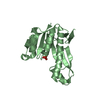
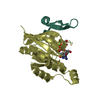
 PDBj
PDBj






